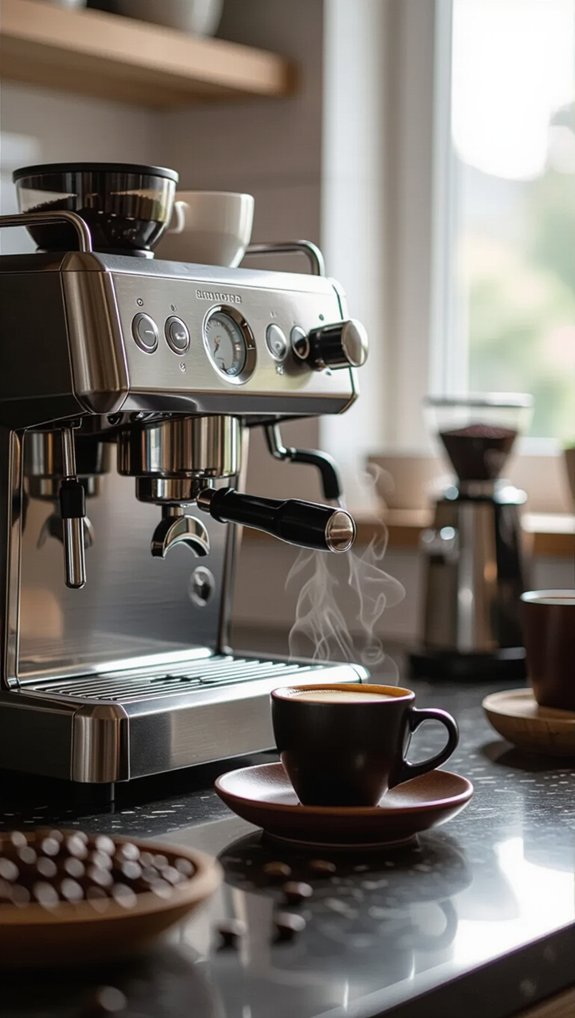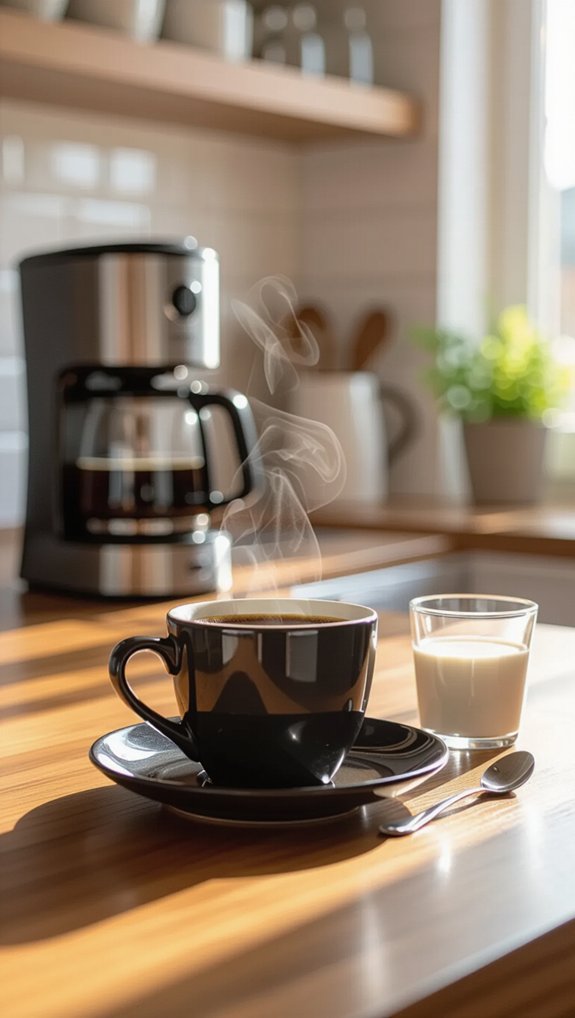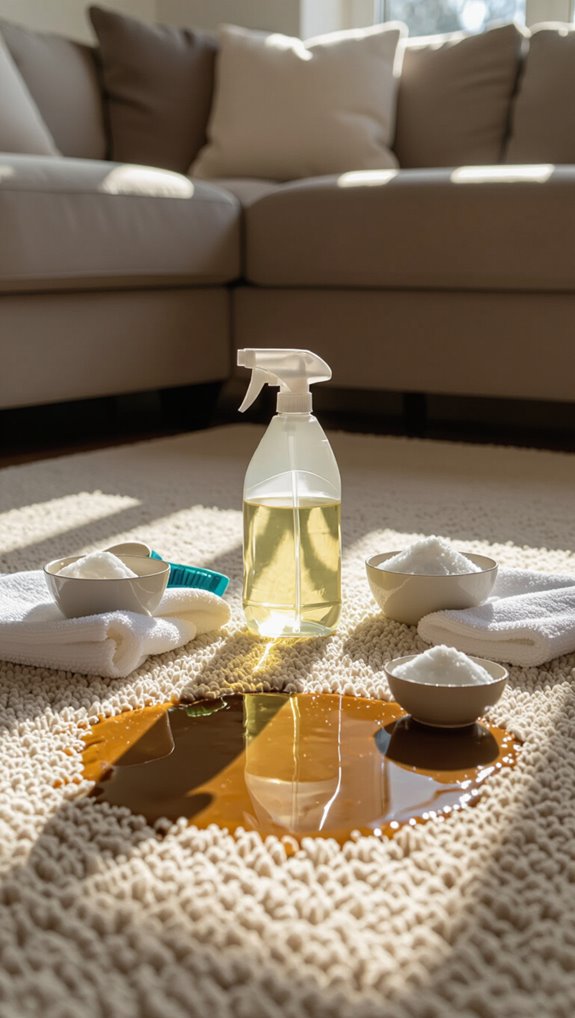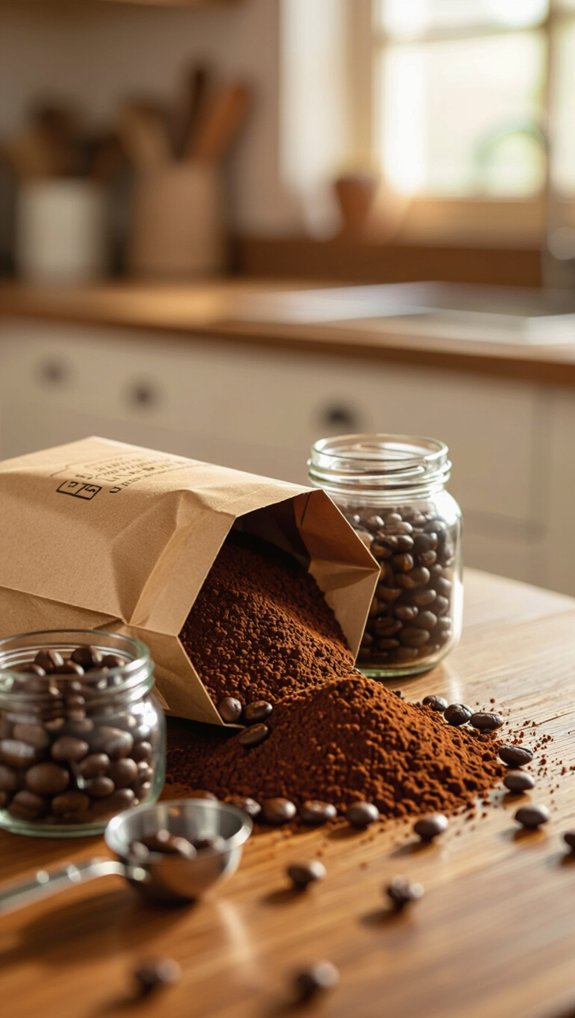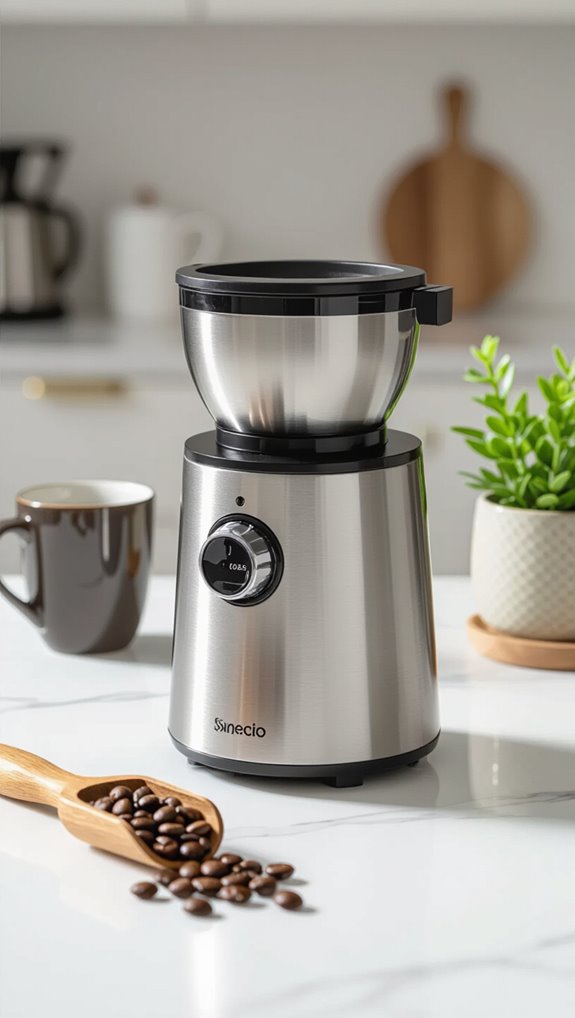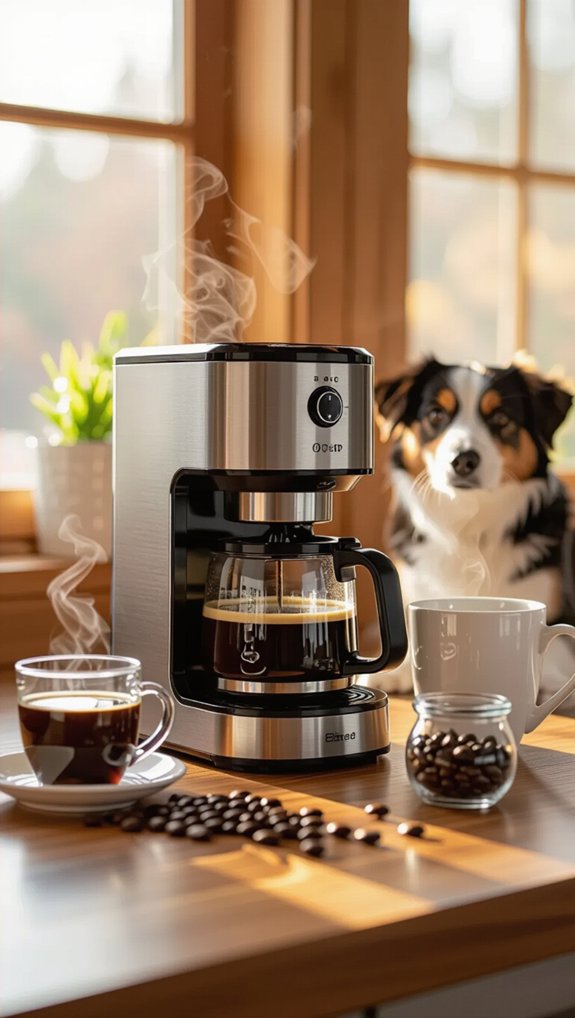When I think about making the perfect cappuccino, I picture that cozy aroma of fresh espresso mingling with the gentle hiss of steamed milk.
You might be curious, what’s the secret to whipping up a truly soul-soothing brew at home? It’s not just about the ingredients—though they’re key—but also the vibe and tools that can transform your morning routine.
From picking the right beans to nailing that elusive microfoam, every step matters.
But what really makes a cappuccino stand out, and how do you dodge the usual slip-ups? Let’s dive into these little details together.
Table of Contents
What is a Cappuccino?

When I think about what makes a cappuccino special, it’s the perfect blend of espresso, steamed milk, and milk foam that creates a balanced and satisfying coffee experience.
Originating in Italy, this drink is named after the Capuchin friars, reflecting the unique color of their robes.
Unlike a latte, which has more steamed milk and less foam, a cappuccino offers a robust coffee flavor complemented by a creamy texture, making it a favorite among coffee enthusiasts.
Definition and Origin
Picture a steaming cup of cappuccino, with its rich brown hue topped by a velvety cloud of foam, inviting you to savor its perfect balance of flavors. This iconic espresso-based drink is a blend of equal parts espresso, steamed milk, and milk foam, embodying the essence of Italian coffee culture.
| Element | Description | Quantity |
|---|---|---|
| Espresso | Rich, bold base | 25 ml |
| Steamed Milk | Smooth, creamy layer | 1/3 cup |
| Milk Foam | Velvety top | 1/3 cup |
Originating as “Kapuziner” in 1700s Vienna, cappuccino evolved into today’s beloved beverage. Named after the Capuchin friars, its color mirrors their robes. With around 75 mg of caffeine, it’s perfect for a balanced energy boost.
Cappuccino vs. Latte: Key Differences
Amidst the spectrum of coffee beverages, cappuccinos and lattes stand out as popular choices, each offering a unique experience.
From my experience, cappuccinos create a bold, rich flavor with a harmonious blend of equal parts espresso, steamed milk, and milk foam, served in a petite 6-ounce cup. Their softer foam adds a comforting texture that coffee enthusiasts adore.
On the other hand, lattes, with their 1:3 espresso-to-milk ratio, provide a creamier, milder taste in larger cups, typically 8 to 12 ounces. The firmer foam atop a latte is subtle yet distinct.
Both drinks share similar caffeine levels, but it’s their texture and flavor intensity that set them apart. Choose based on your preference for richness or creaminess.
Choosing the Right Ingredients
When making a cappuccino, I always start with high-quality medium roast espresso beans, which I grind fresh for that rich, robust flavor we all crave.
For milk, my go-to is whole milk due to its creaminess and frothing capability, but I’ve found oat milk to be a fantastic alternative for a vegan option.
To finish, a light dusting of cocoa or cinnamon adds both flavor and visual appeal to the perfect cappuccino.
Espresso Coffee
Choosing the right espresso coffee is vital for crafting a delicious cappuccino. I always opt for high-quality medium roast espresso beans. They offer a balanced flavor profile, especially when you use 14-18 grams for a double shot. The fine grind size is essential for extracting rich flavors. For the best results, use beans roasted within the last 2-4 weeks to guarantee freshness. I’ve found experimenting with different brands can introduce delightful variations, but I prefer those with dark, bitter notes. Popular choices often include chocolatey or nutty undertones, which pair beautifully with milk.
Here’s a quick comparison:
| Roast Type | Flavor Notes | Grind Size |
|---|---|---|
| Medium | Balanced, Bitter | Fine |
| Dark | Chocolatey, Nutty | Fine |
| Light | Fruity, Floral | Fine |
Milk Options – Whole, Almond, Oat
A great cappuccino isn’t just about the espresso; the milk you choose plays an equally important role in the drink’s final taste and texture.
I often start with whole milk for its rich, creamy texture that complements the espresso beautifully. It froths perfectly, creating that luscious foam we all love.
However, when I want something lighter, almond milk comes into play. It’s low-calorie but can struggle with stable foam, slightly altering the cappuccino’s mouthfeel.
Oat milk, now a popular trend, froths almost as well as whole milk while delivering a natural sweetness, ideal for those who prefer a dairy-free option.
It’s fascinating how these choices impact the cappuccino’s character, so I recommend trying each to discover your favorite.
Optional Toppings – Cocoa, Cinnamon
Enhancing your cappuccino with the right toppings can transform a simple coffee into a gourmet experience.
I’ve found that a dusting of unsweetened cocoa powder not only elevates its visual charm but enriches the flavor with a delightful chocolatey note that pairs beautifully with the coffee’s bitterness.
On the other hand, a sprinkle of ground cinnamon adds a warm, spicy touch, and it boasts health perks like anti-inflammatory benefits.
Using high-quality cocoa and fresh cinnamon is essential—they can make all the difference.
I love experimenting with different ratios to suit my mood, ensuring each cup feels uniquely mine.
For an added treat, I sometimes create latte art with the milk foam before adding these toppings, offering both visual and taste satisfaction.
Equipment You Need
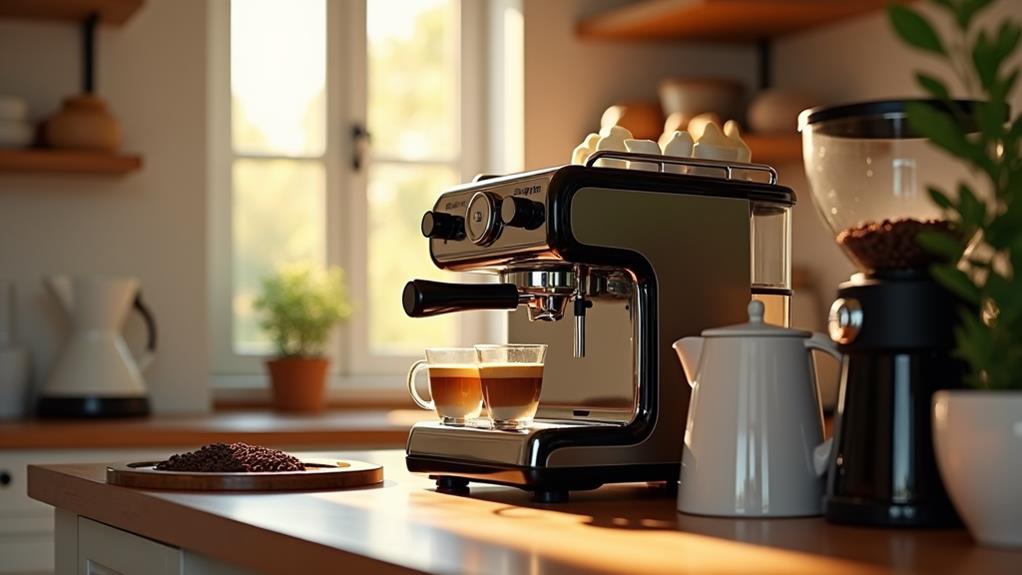
When making a cappuccino, the espresso machine with a steam wand is my go-to for achieving that perfect espresso shot and creamy milk foam; it’s a bit of an investment but worth every penny if you’re serious about your coffee.
For those who prefer a more hands-on approach, using a milk jug with a thermometer allows precise control over the milk’s temperature, ensuring it doesn’t overheat while frothing.
Alternatively, a handheld frother is a convenient option, especially if you’re just starting out and looking for a budget-friendly way to practice your frothing skills.
Espresso Machine with Steam Wand
To craft the perfect cappuccino, you’ll need an espresso machine with a steam wand, which is essential for creating frothy milk with the ideal microfoam texture.
Look for machines with a stainless steel wand for better heat retention, helping you steam milk to the best 150-155°F.
In my experience, models with dual boiler systems are a game-changer, letting you brew espresso and steam milk simultaneously, saving precious minutes.
Adjustable steam pressure settings are a boon, allowing customization of milk textures to suit your preferences.
Regular cleaning is non-negotiable; it prevents milk residue buildup that can spoil flavors.
Consider these features against your budget and needs.
Investing in a machine that fits your style is key to achieving that café-quality cappuccino at home.
Milk Jug and Thermometer
Crafting a delightful cappuccino starts with the right tools, and a milk jug is at the top of the list.
I’ve tested stainless steel jugs, and they’re unmatched for durability and heat retention. Look for one with a spout—vital for precise pouring and creating latte art. A 12-ounce capacity is ideal, accommodating several cups at once.
The jug’s design matters; a narrower base encourages effective steam circulation, resulting in better foam.
The right thermometer is equally important. It guarantees milk reaches the sweet spot of 150-155°F, perfect for texture without scalding.
I recommend investing in a reliable one to avoid over or under-heating. Combining these tools enhances your cappuccino-making experience, letting you focus on crafting that soul-soothing brew.
Handheld Frother (Alternative)
While a milk jug and thermometer are staples for many, a handheld frother offers a fantastic alternative for those seeking simplicity and convenience. It’s portable, runs on batteries, and froths milk in under a minute. To use it, immerse the whisk into your milk of choice, turn it on, and move it in a circular motion. You’ll soon see the milk double in volume with a creamy texture.
Here’s a quick comparison:
| Feature | Handheld Frother | Milk Jug & Thermometer |
|---|---|---|
| Portability | High | Low |
| Ease of Use | Very Easy | Moderate |
| Frothing Speed | Less than a minute | Varies |
| Milk Types | Versatile | Usually whole milk |
| Cleaning | Easy with stainless steel | Requires thorough wash |
Whether you prefer whole milk or almond milk, a handheld frother caters to your needs with ease.
Step-by-Step Cappuccino Recipe
Let’s get started on crafting a perfect cappuccino by first gathering the essentials: a reliable espresso machine, a milk frother, high-quality medium roast coffee, and whole milk.
Begin by pulling a rich shot of espresso, aiming for that ideal 0.7-0.8 oz per serving, and then steam your milk to a silky 150-155°F.
With your ingredients ready, combine them to create a creamy, balanced cup, and don’t forget that final touch of cocoa or cinnamon for an authentic finish.
Equipment
- Espresso machine or moka pot for brewing espresso
- Milk frother or steam wand for frothing milk
- Preheated cup or mug to maintain drink temperature
- Optional: Nespresso machine for convenient espresso-making
Ingredients
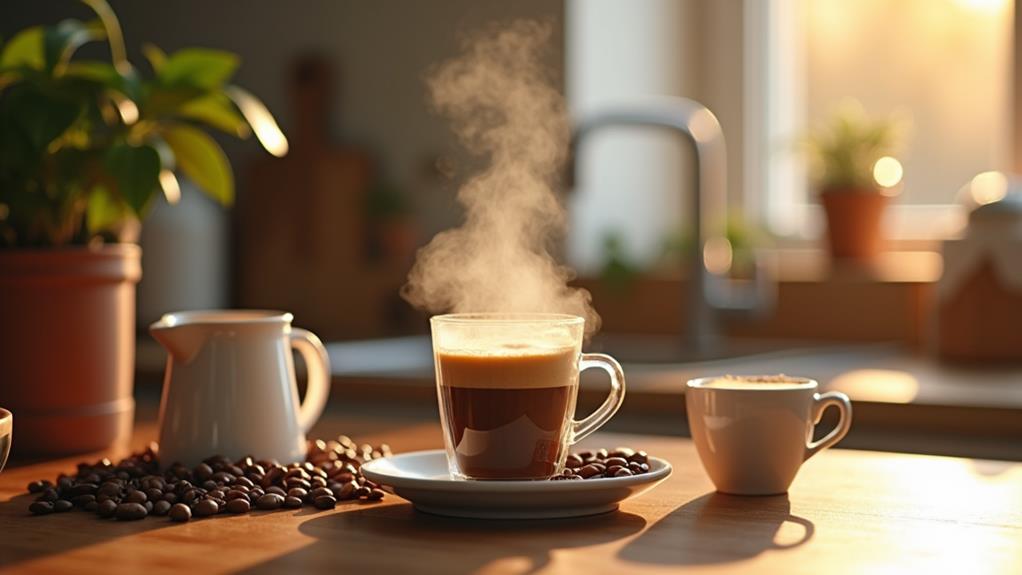
- 25 ml (0.84 oz) of freshly brewed espresso from high-quality medium roast coffee beans
- 100 ml (3.38 oz) of steamed whole milk (or oat/almond milk for a vegan option)
- 25 ml (0.84 oz) of milk foam
- Optional: sugar, flavored syrups, or a sprinkle of cocoa powder for added flavor
Method
- Begin by brewing one or two shots of espresso using fresh, high-quality medium roast coffee beans for ideal flavor.
- Heat approximately 100-125 ml of milk to 150-155°F and use a milk frother to create velvety foam that doubles in size.
- Pour the brewed espresso into a preheated cup.
- Add the steamed milk to the cup, filling it to your desired level.
- Spoon the frothed milk on top, aiming for a 1:1:1 ratio of espresso, steamed milk, and foam.
- Optionally, sprinkle cocoa powder or cinnamon on top for added flavor and visual appeal.
- Serve the cappuccino immediately to enjoy the best taste experience.
- Experiment with different milk types, such as whole or oat milk, to find your preferred texture and flavor.
Perfecting the Foam
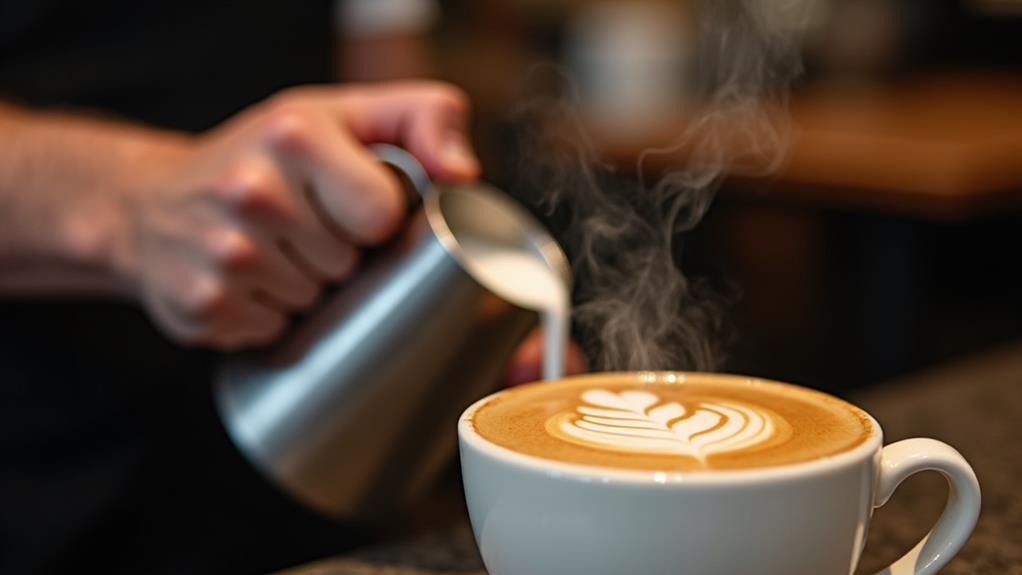
Perfecting the foam is all about creating microfoam, which is essential for that creamy cappuccino texture.
I find that using a steam wand just below the surface of whole milk at around 150-155°F helps achieve a velvety consistency.
Creating Microfoam
To create the perfect microfoam for your cappuccino, start with cold, fresh whole milk. I find whole milk’s higher fat content froths beautifully, delivering a rich texture.
My trusty steam wand, positioned just below the milk’s surface, incorporates air effectively, doubling the milk’s volume. You should aim for a temperature of around 145°F, ensuring a velvety texture without burning.
I’ve learned that achieving a 1:1 milk-to-foam ratio makes for a seamless blend with espresso. Practicing the rolling technique while steaming—gently swirling the milk—helps maintain a consistent microfoam and prevents large bubbles.
The result? A glossy sheen that resembles liquid silk, holding its shape nicely when poured. This technique consistently enhances my coffee experience, offering superb value in each cup.
Tips for Foamed Milk
With a bit of practice, you’ll find that fresh whole milk is your best friend when aiming for perfect foamed milk in a cappuccino. Its higher fat content guarantees a creamier texture and a froth that’s unrivaled by lower-fat options.
When steaming, I aim for a temperature between 150-155°F to avoid a burnt taste. Positioning the steam wand just below the milk’s surface introduces air, creating a velvety microfoam.
I experimented with handheld frothers and whisks, but an espresso machine steam wand delivers the best results. For that traditional 1:1:1 cappuccino ratio, balance espresso, steamed milk, and foam.
Common Mistakes to Avoid
When you’re making a cappuccino, overheating the milk can really spoil your drink by giving it an unpleasant burnt taste, so I always aim to hit that sweet spot of 150-155°F.
Another common error is using the wrong espresso shot; sticking to freshly brewed espresso guarantees the rich flavor that instant coffee just can’t deliver.
I’ve found that paying attention to these details makes a world of difference in achieving that perfect cup.
Overheating Milk
One of the most common mistakes in making a cappuccino is overheating the milk, which can ruin both its taste and texture.
I’ve found that keeping the milk temperature between 150-155°F guarantees a delightful, velvety froth. Overheating can break down the proteins, leaving you with a burnt taste and foam that collapses quickly.
When using my espresso machine, I always aim for a gentle swirl instead of a vigorous boil, which helps maintain the milk’s sweetness.
I’ve noticed that milk close to its expiration date doesn’t froth as well, especially if overheated.
By holding the steaming wand just below the milk’s surface, I achieve the perfect balance of steam and foam without scalding it.
This simple step can transform your cappuccino experience.
Incorrect Espresso Shot
A well-crafted espresso shot is the heart of a perfect cappuccino, but it’s easy to make mistakes that can compromise its quality. I’ve learned that using coffee beans that are too coarse or not freshly ground results in an under-extracted shot, weakening the cappuccino’s flavor. On the flip side, over-tamping can lead to a bitter taste. The brewing temperature is essential; too hot scorches the coffee, while too cool leads to sourness. Also, the shot should brew in 25-30 seconds. Here’s a quick guide:
| Mistake | Result |
|---|---|
| Coarse grind | Weak flavor |
| Over-tamping | Bitter taste |
| Incorrect temp | Scorched or sour flavors |
| Too long/short | Inconsistent brew |
| Stale beans | Flat taste |
Keep these tips in mind for a satisfying cup!
Cappuccino Pairings and Variations

When enjoying a cappuccino, pairing it with a sweet pastry like a croissant or biscotti can enhance the coffee’s rich flavors and provide a delightful contrast in texture.
For those looking to experiment, adding flavored syrups such as vanilla or caramel can give your cappuccino a unique twist without overpowering the espresso’s essence.
Seasonal variations like pumpkin spice or peppermint mocha offer festive flair, while a sprinkle of cinnamon or nutmeg not only boosts flavor but also adds a hint of health benefits, especially when using dairy-free options like almond or oat milk for a creamy finish.
What to Serve with a Cappuccino
As you sit down to enjoy a cappuccino, consider enhancing your experience with well-chosen pairings.
I’ve found that light pastries, like croissants or biscotti, perfectly complement the creamy milk foam, creating a harmonious taste journey.
If you’re a fan of chocolate, dark chocolate or chocolate-based desserts can heighten the cappuccino’s rich notes, balancing bitterness with sweetness.
For an invigorating twist, fresh fruits such as berries or citrus bring a lively contrast to the creamy texture.
On days when I crave something savory, cheese scones or quiches offer a satisfying counterpoint to the cappuccino’s sweetness.
Don’t hesitate to experiment with flavored variations; adding spices like cinnamon or nutmeg can transform your cappuccino into a personalized masterpiece.
Specialty Flavors and Spins
With specialty flavors and creative spins, a cappuccino can transform from a simple pleasure into a personalized delight.
Let’s explore some options. Adding flavored syrups like vanilla, caramel, or hazelnut can enhance your drink, though they do add calories. For a mocha twist, incorporate chocolate syrup or cocoa powder. It’s a great choice if you love a rich chocolate-coffee combination.
Spice it up with cinnamon or nutmeg sprinkled on the foam for warmth and antioxidants.
Pair your cappuccino with biscotti or pastries for a delightful balance.
Vegan variations using oat or almond milk froth beautifully, offering different flavor profiles. Each choice caters to diverse preferences, ensuring everyone finds a perfect match for their taste and dietary needs.
Frequently Asked Questions
How Can I Make a Cappuccino With Non-Dairy Milk?
Grab some fresh oat milk for a creamy froth. Heat it to 140°F, then froth it up for that silky foam. Try different brands till you find your fave. Enjoy your non-dairy cappuccino!
What Is the Ideal Water Temperature for Brewing Espresso?
For killer espresso, keep water between 190°F and 205°F. This sweet spot nails the flavor without any bitterness. Let your machine heat up properly before you start.
How Do I Clean and Maintain My Espresso Machine?
I keep my espresso machine in top shape by brushing the portafilter and group head, descaling monthly, rinsing the steam wand, and deep cleaning parts. These quick steps make sure it’s always running like a champ.
Can I Use Flavored Syrups in My Cappuccino?
Sure thing! Toss in some flavored syrup before the espresso for a balanced taste. Just don’t go overboard, or you’ll drown out the coffee’s vibe and rack up the cals. Have fun mixing it up!
What Is the Difference Between a Cappuccino and a Latte?
Cappuccinos mix equal parts espresso, steamed milk, and foam. Lattes go heavy on the steamed milk. Lattes are creamier, often bigger, and can come with syrups. Keep it simple: cappuccino = balanced; latte = milkier.
In Conclusion
Making a killer cappuccino at your place is all about nailing the right ingredients and technique. Grab some fresh, medium roast beans and get that espresso, steamed milk, and frothy milk balanced just right.
Want to make it your own? Sprinkle on some cocoa or cinnamon for that extra kick. With the right gear and a bit of practice, you’ll be sipping on a cup that screams Italian coffee culture with every gulp.
References:
National Italian American Foundation. “Italian Coffee Culture.” https://www.niaf.org/culture/food-and-wine/italian-coffee-culture/
Illy. “The Art of Espresso.” https://www.illy.com/en-us/coffee/coffee-preparation/espresso
Istituto Nazionale Espresso Italiano. “Il Rito dell’Espresso.” https://www.espressoitaliano.org/en/espresso-italian-taste/
Accademia Italiana Maestri del Caffè. “Espresso Italiano.” https://www.aicaf.com/en/espresso-italiano/
Italian Tourism Official Website. “Coffee in Italy: 10 Commandments.” http://www.italia.it/en/travel-ideas/food-and-wine/coffee-in-italy-10-commandments.html


